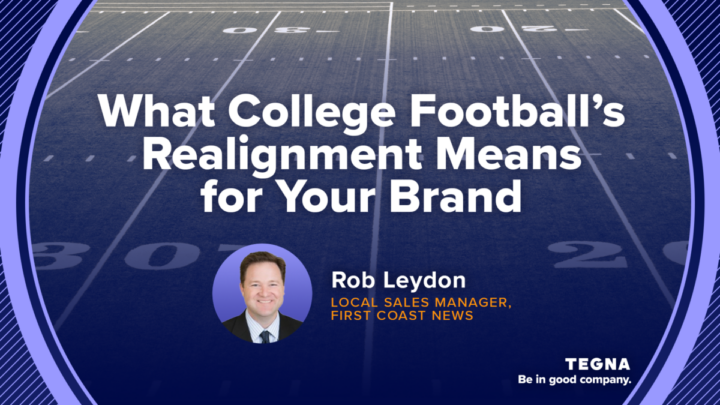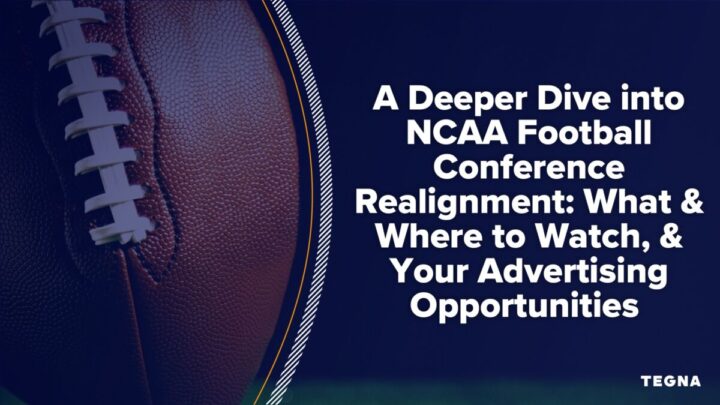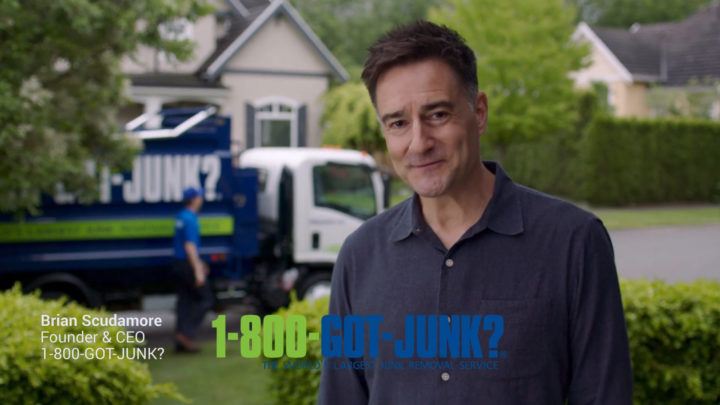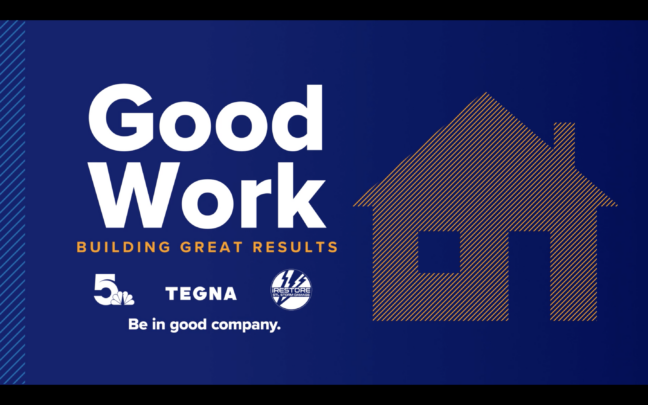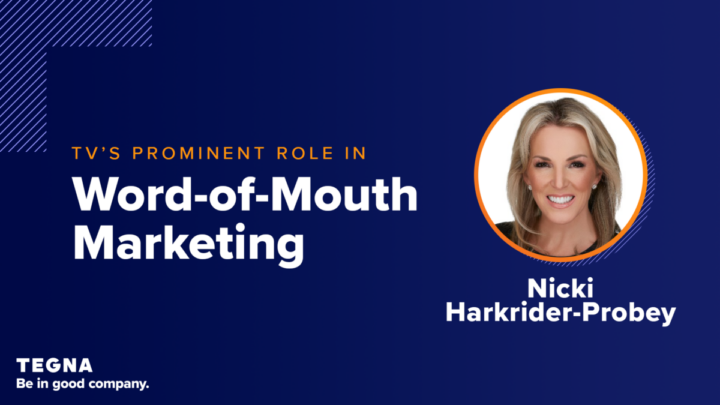TEGNA Media Brands Respond to the George Floyd Movement, Lead With Quality Journalism
In this installment of the ‘Marketing Amidst a Movement’ series, we take a look at the media category, including responses from local TEGNA brands WKYC, WXIA, WUSA, and more.

TEGNA dedicates our ‘Marketing Amidst a Movement’ series to our minority-owned business partners and clients. We celebrate their resilience and determination and join in their commitment to building more diverse marketplaces across our communities. Part of our commitment includes a $100,000 donation to the NAACP Legal Defense Fund.
———————-
On May 25, 2020, the world – already under duress with the coronavirus – dramatically changed. On that day, George Floyd was killed by Minneapolis police officers. Despite cries of “please” and “I can’t breathe,” Floyd was pinned down by his neck for eight minutes and thirty-six seconds. Bystanders tried to intervene but to no avail. The entire incident was captured on video and quickly went viral sparking national outrage.
Minneapolis residents quickly rose to support racial equality and protest police brutality. As the video of Floyd’s death spread from the American Midwest to destinations all over the world, a historic movement began. However, in some cases, peaceful protests turned violent, and in some cities, curfews were installed to protect against looting.
Consumers quickly dug into researching corporate statements and asked questions about what types of policies, partnerships, investments, and behaviors companies had in place. Were brands truly committed to their words? Where there were words without actions, they took to social media to call brands out.
It can be challenging, controversial, and even paralyzing for a company to consider their response to something as outrageous as the George Floyd events with this level of scrutiny in play. Over the next several weeks, our team will look at a variety of categories to explore how various brands are responding to calls for social justice.
We first examine the media sector with a look both at ourselves and our 62 stations in 51 markets throughout the country, as well as companies across traditional, digital, and streaming media.
TEGNA Stations Respond
“At TEGNA, we give our local stations the complete autonomy to determine their approach. They weighed several factors including journalistic ethics, their role as community leaders, the commitments they wanted to make to their staffs, and more,” says Meredith Conte, Vice President of Marketing for TEGNA.
Across the board, TEGNA stations led with quality journalism, ensuring that audiences had timely, accurate, and contextual coverage. They dedicated countless hours of coverage, giving new voices and shining new lights on an unfortunate story of social injustice that we’ve seen too often.
As TEGNA teams continued to watch the situations unfold in their market, many came to realize that unlike most news stories, there were not two sides to the story of George Floyd and the Minneapolis police department. There was simply the side of human rights. Above and beyond their coverage, many stations crafted messaging that aimed to unify, motivate, and advocate for social justice.
WKYC Shares the Love in Cleveland
“Market research shows consumers, especially those 40 years of age and younger, are more compelled to support socially responsible businesses,” says John Forgetta, Brand & Marketing Director at WKYC in Cleveland.
“But, quite frankly, it’s not about business, it’s about doing what’s right and just and good. We responded quickly with a message that was authentic to the inclusive values we hold as an organization. Our messaging centered on love.”
In the midst of protests, during a time when Cleveland was uncertain, unsafe, and scared, the market found comfort in the simplicity of WKYC’s approach.
“It was an eerie and emotional night and because viewers have an expectation of immediacy from television news, we believed that responding quickly was paramount for the good of the community and the integrity of our brand,” says Forgetta.
WXIA Inspires Change in Atlanta
In Atlanta, what started as a peaceful protest quickly turned into a night of violence, anger, and confusion.
“It would have been inauthentic for us to stay on the sidelines,” says Wes Rodda, Director of Marketing at 11Alive. “Our brand position is Where Atlanta Speaks, so we knew how important it is for us to represent the viewpoints of our audience.”
11Alive chose to amplify powerful excerpts from press conferences featuring Atlanta mayor, Keisha Lance Bottoms, and Dr. Bernice King, the daughter of Dr. Martin Luther King Jr.
“The first people we looked to were our community leaders. They were out in front early on, trying to bring calm to an unprecedented and volatile situation,” says Rodda of 11Alive’s messaging.
In their respective comments, Bottoms states that she recognizes and understands the feelings that led to the anger and unrest, but urges, “there will have to be a peaceful way in which we can resolve this systematic issue that plagues us as a country.” King’s message also called for peace. “We’ve got to deal with systemic racism and white supremacy once and for all. But the only pathway I know to do this is through non-violent means. It is a proven method. It did not fail my father.”
At the end of each message, 11Alive concludes urging audiences to “use your voice to bring change.” After seeing the initial positive response to their approach, 11Alive expanded the on-air messaging to the out of home space, utilizing a highly visible LED billboard that carried the message during continued protesting.
WTLV Amplifies the Sounds of the Movement
In Jacksonville, First Coast News aired a press conference with members of Jacksonville’s City Council and School Board. Upon hearing powerful language from event participants, First Coast News produced this message, featuring positive phrases such as: “we hear your voices” and “there is time for a change.”
The team also partnered with 12-year old Jacksonville student and vocalist, Keedron Bryant, whose performance of “I just wanna live” struck an emotional chord with the market.
“It’s unfair that we can’t go out and like the song says, live,” Bryant says in the spot. “We can’t go out and enjoy life and not be afraid.”
“Working with Keedron was such a privilege,” says Kristen Joyal, marketing director at First Coast News. “His voice has inspired our First Coast News community and our team is dedicated to quality journalism and impactful messaging that crafts a brighter future for children just like him.”
WUSA Lets Voices be Heard
Based in Washington, D.C., WUSA9 is a motivated news organization with a mission to inform, inspire, and impact the local community. Their coverage focus throughout area protests was to ensure voices were heard. They made a commitment to play the role of a megaphone in the community.
When the time came to share messaging outside of their newscasts, WUSA9 simply put a mirror up to the market and reflected the many stories and voices they saw and heard on the streets of the city.
“We have received positive viewer feedback thanking us for letting real people talk and for sending reporters to the protests to not just cover the story but actively listen,” says Erin McCahill, Head of Marketing and Brand at WUSA.
WUSA’s response also included commentary from Reese Waters, host of the station’s ‘Get Up DC’ morning show. Reese shared his “Final Thought” on-air, and on Twitter, in which he encourages audiences to get out and vote.
“What is needed to change deep-seated injustice is policy – government-enacted policy – and that’s where the ballot box comes in. That’s where change happens – the Civil Rights Act, The Voting Rights Act, the Equal Pay Act, the Affordable Care Act – all have happened because citizens have voted people into office who work hard to enact those policies.”
We have seen throughout history how important the act of protest is. Throwing tea into a harbor. Raising fists into the air. Kneeling. Each of these acts brought eyes to an injustice. But what is needed to change deep seated injustice is policy #GetUpDC #BlackLivesMatter pic.twitter.com/UsqNwYOsDK
— Reese Waters (@reesewaters) June 4, 2020
Every approach was unique to their news organization and specific to the community they serve. This is one take away for every brand: when it comes to social response and brand activism, the response must be authentic. It must be a response that is inextricably linked to an organization’s own truths.
Entertainment companies echoed this sentiment as well, opting to work within their content platforms to amplify their response.
Netflix Amplifies Black Storytelling
Popular streamer, Netflix, created a Black Lives Matter section within its platform. Featuring films that highlight systemic racism – 13th, LA 92, Fruitvale Station, Dear White People – Netflix is able to provide educational resources to help curb racism and provide perspective.
In a written statement Netflix says, “When we say ‘Black Lives Matter,’ we also mean ‘Black storytelling matters. With an understanding that our commitment to true, systemic change will take time – we’re starting by highlighting powerful and complex narratives about the Black experience. When you log onto Netflix today, you will see a carefully curated list of titles that only begin to tell the complex and layered stories about racial injustice and Blackness in America.”
Among titles attracting attention is Dave Chappelle’s surprise special 8:46, in which the comedian offers an unrefined and raw take on the events surrounding Floyd’s Death in a socially-distanced setting.
HBO Adds Historical Context to ‘Racist’ Film
Meanwhile, fellow entertainment company HBO removed “Gone with the Wind” from the platform, only to re-release the movie with added historical context.
In a statement, HBO says, “’Gone With The Wind’ is a product of its time and depicts some of the ethnic and racial prejudices that have, unfortunately, been commonplace in American society. These racist depictions were wrong then and are wrong today, and we felt that to keep this title up without an explanation and a denouncement of those depictions would be irresponsible.”
From entertainment to news and across the media sector, we have seen dozens of brand responses. And as the story evolves, many brands speaking out are now looking introspectively at their own diversity and inclusion practices to ensure any statements they make can be backed up with specific commitments, actions, policies, investments, and employee expectations.
This is one of the bigger takeaways we have noticed. Words and messages are not enough. The death of George Floyd has sparked a movement and the movement demands action. From diversity and inclusion training to new policies around hiring to the establishment of employee resource groups, media companies and many others are taking this moment to make sure they don’t just say the right thing but they actually do the right thing.
Do you have thoughts you’d like to share on how companies are responding to issues presented by the George Floyd case? We’d love to hear from you. Click here to share your perspective.


